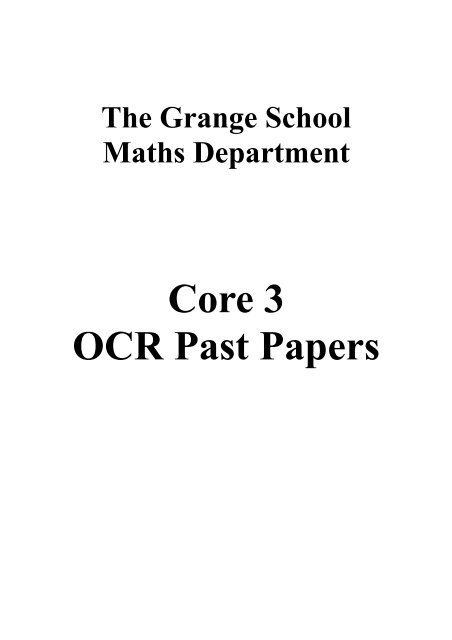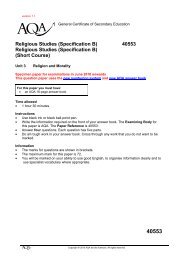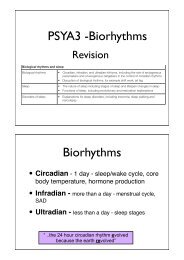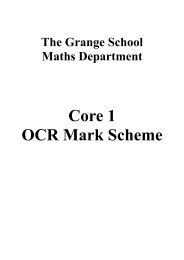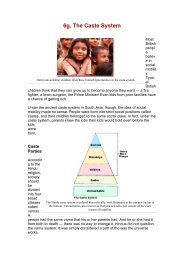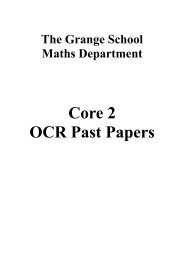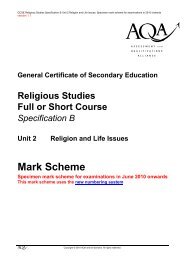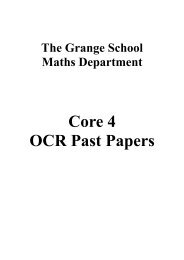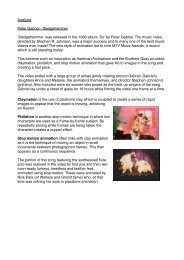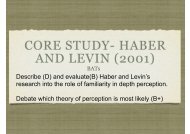Core 3 OCR Past Papers - The Grange School Blogs
Core 3 OCR Past Papers - The Grange School Blogs
Core 3 OCR Past Papers - The Grange School Blogs
Create successful ePaper yourself
Turn your PDF publications into a flip-book with our unique Google optimized e-Paper software.
<strong>The</strong> <strong>Grange</strong> <strong>School</strong><br />
Maths Department<br />
<strong>Core</strong> 3<br />
<strong>OCR</strong> <strong>Past</strong> <strong>Papers</strong>
2<br />
June 2005<br />
1 <strong>The</strong> function f is defined for all real values of x by<br />
f(x) =10 −(x + 3) 2 .<br />
(i) State the range of f. [1]<br />
(ii) Find the value of ff(−1). [3]<br />
2 Find the exact solutions of the equation |6x − 1| = |x − 1|. [4]<br />
3 <strong>The</strong> mass, m grams, of a substance at time t years is given by the formula<br />
m = 180e −0.017t .<br />
(i) Find the value of t for which the mass is 25 grams. [3]<br />
(ii) Find the rate at which the mass is decreasing when t = 55. [3]<br />
4 (a)<br />
<strong>The</strong> diagram shows the curve y = 2 √ x<br />
. <strong>The</strong> region R, shaded in the diagram, is bounded by the<br />
curve and by the lines x = 1, x = 5andy = 0. <strong>The</strong> region R is rotated completely about the x-axis.<br />
Find the exact volume of the solid formed. [4]<br />
(b)<br />
Use Simpson’s rule, with 4 strips, to find an approximate value for<br />
<br />
1<br />
5<br />
√ (x 2 + 1) dx,<br />
giving your answer correct to 3 decimal places. [4]<br />
5 (i) Express 3 sin θ + 2cosθ in the form R sin(θ + α), whereR > 0and0 ◦ < α < 90 ◦ . [3]<br />
(ii) Hence solve the equation 3 sin θ + 2cosθ = 7 2 , giving all solutions for which 0◦ < θ < 360 ◦ . [5]<br />
4723/S05
3<br />
June 2005<br />
6 (a) Find the exact value of the x-coordinate of the stationary point of the curve y = x ln x. [4]<br />
(b)<br />
<strong>The</strong>equationofacurveisy = 4x + c ,wherec is a non-zero constant. Show by differentiation<br />
4x − c<br />
that this curve has no stationary points. [3]<br />
7 (i) Write down the formula for cos 2x in terms of cos x. [1]<br />
(ii) Prove the identity<br />
(iii) Solve, for 0 < x < 2π, the equation<br />
4cos2x<br />
1 + cos 2x ≡ 4 − 2sec2 x. [3]<br />
4cos2x = 3tanx − 7. [5]<br />
1 + cos 2x<br />
8<br />
<strong>The</strong> diagram shows part of each of the curves y = e 1 5 x and y = 3√ (3x + 8). <strong>The</strong> curves meet, as shown<br />
in the diagram, at the point P. <strong>The</strong> region R, shaded in the diagram, is bounded by the two curves and<br />
by the y-axis.<br />
(i) Show by calculation that the x-coordinate of P lies between 5.2 and 5.3. [3]<br />
(ii) Show that the x-coordinate of P satisfies the equation x = 5 ln(3x + 8). [2]<br />
3<br />
(iii) Useaniterativeformula,basedontheequationinpart(ii), tofindthex-coordinate of P correct<br />
to 2 decimal places. [3]<br />
(iv) Use integration, and your answer to part (iii), to find an approximate value of the area of the<br />
region R. [5]<br />
[Question 9 is printed overleaf.]<br />
4723/S05 [Turn over
June 2005<br />
4<br />
9<br />
<strong>The</strong> function f is defined by f(x) = √ (mx + 7)−4, where x ≥− 7 m<br />
diagram shows the curve y = f(x).<br />
and m is a positive constant. <strong>The</strong><br />
(i) A sequence of transformations maps the curve y = √ x to the curve y = f(x). Give details of these<br />
transformations. [4]<br />
(ii) Explain how you can tell that f is a one-one function and find an expression for f −1 (x). [4]<br />
(iii) It is given that the curves y = f(x) and y = f −1 (x) do not meet. Explain how it can be deduced<br />
that neither curve meets the line y = x, and hence determine the set of possible values of m. [5]<br />
4723/S05
Jan 2006<br />
1 Show that <br />
2<br />
8<br />
2<br />
3<br />
dx = ln 64. [4]<br />
x<br />
2 Solve, for 0 ◦ < θ < 360 ◦ , the equation sec 2 θ = 4tanθ − 2. [5]<br />
3 (a) Differentiate x 2 (x + 1) 6 with respect to x. [3]<br />
(b) Find the gradient of the curve y = x2 + 3<br />
x 2 at the point where x = 1. [3]<br />
− 3<br />
4<br />
<strong>The</strong> function f is defined by f(x) =2 − √ x for x ≥ 0. <strong>The</strong> graph of y = f(x) is shown above.<br />
(i) State the range of f. [1]<br />
(ii) Find the value of ff(4). [2]<br />
(iii) Given that the equation |f(x)| = k has two distinct roots, determine the possible values of the<br />
constant k. [2]<br />
5<br />
<strong>The</strong> diagram shows the curves y =(1 − 2x) 5 and y = e 2x−1 − 1. <strong>The</strong>curvesmeetatthepoint( 1 2 ,0).<br />
Find the exact area of the region (shaded in the diagram) bounded by the y-axis and by part of each<br />
curve. [8]<br />
4723/Jan06
Jan 2006<br />
6 (a)<br />
3<br />
t 0 10 20<br />
X 275 440<br />
<strong>The</strong> quantity X is increasing exponentially with respect to time t. <strong>The</strong> table above shows values<br />
of X for different values of t. Find the value of X when t = 20. [3]<br />
(b)<br />
<strong>The</strong> quantity Y is decreasing exponentially with respect to time t where<br />
Y = 80e −0.02t .<br />
(i) Find the value of t for which Y = 20, giving your answer correct to 2 significant figures.<br />
[3]<br />
(ii) Find by differentiation the rate at which Y is decreasing when t = 30, giving your answer<br />
correct to 2 significant figures. [3]<br />
7<br />
<strong>The</strong> diagram shows the curve with equation y = cos −1 x.<br />
(i) Sketch the curve with equation y = 3cos −1 (x − 1), showing the coordinates of the points where<br />
the curve meets the axes. [3]<br />
(ii) By drawing an appropriate straight line on your sketch in part (i), show that the equation<br />
3cos −1 (x − 1) =x has exactly one root. [1]<br />
(iii) Show by calculation that the root of the equation 3 cos −1 (x − 1)=x lies between 1.8 and 1.9. [2]<br />
(iv) <strong>The</strong>sequencedefinedby<br />
x 1<br />
= 2, x n+1<br />
= 1 + cos( 1 3 x n )<br />
converges to a number α. Findthevalueofα correct to 2 decimal places and explain why α is<br />
the root of the equation 3 cos −1 (x − 1) =x. [5]<br />
[Questions 8 and 9 are printed overleaf.]<br />
4723/Jan06<br />
[Turn over
8<br />
Jan 2006<br />
4<br />
<strong>The</strong> diagram shows part of the curve y = ln(5 − x 2 ) which meets the x-axis at the point P with<br />
coordinates (2, 0). <strong>The</strong> tangent to the curve at P meets the y-axis at the point Q. <strong>The</strong> region A is<br />
bounded by the curve and the lines x = 0andy = 0. <strong>The</strong> region B is bounded by the curve and the<br />
lines PQ and x = 0.<br />
(i) Find the equation of the tangent to the curve at P. [5]<br />
(ii) Use Simpson’s Rule with four strips to find an approximation to the area of the region A, giving<br />
your answer correct to 3 significant figures. [4]<br />
(iii) Deduce an approximation to the area of the region B. [2]<br />
9 (i) By first writing sin 3θ as sin(2θ + θ), showthat<br />
sin 3θ = 3sinθ − 4sin 3 θ. [4]<br />
(ii) Determine the greatest possible value of<br />
9sin( 10<br />
3 α) − 12 sin3 ( 10<br />
3 α),<br />
and find the smallest positive value of α (in degrees) for which that greatest value occurs. [3]<br />
(iii) Solve, for 0 ◦ < β < 90 ◦ , the equation 3 sin 6β cosec 2β = 4. [6]<br />
4723/Jan06
2<br />
June 2006<br />
1 Find the equation of the tangent to the curve y = √ 4x + 1atthepoint(2, 3). [5]<br />
2 Solve the inequality |2x − 3|
6<br />
June 2006<br />
3<br />
<strong>The</strong> diagram shows the graph of y = f(x),where<br />
f(x) =2 − x 2 , x ≤ 0.<br />
(i) Evaluate ff(−3). [3]<br />
(ii) Find an expression for f −1 (x). [3]<br />
(iii) Sketch the graph of y = f −1 (x). Indicate the coordinates of the points where the graph meets the<br />
axes. [3]<br />
7 (a) Find the exact value of <br />
(b)<br />
1<br />
2<br />
2<br />
dx. [4]<br />
(4x − 1)<br />
2<br />
<strong>The</strong> diagram shows part of the curve y = 1 x .<strong>The</strong>pointP has coordinates (a, 1 ) and the point Q<br />
a<br />
1<br />
has coordinates (2a, ),wherea isapositiveconstant.<strong>The</strong>pointR is such that PR is parallel<br />
2a<br />
to the x-axis and QR is parallel to the y-axis. <strong>The</strong> region shaded in the diagram is bounded by<br />
the curve and by the lines PR and QR. Show that the area of this shaded region is ln( 1 e). [6]<br />
2<br />
4723/S06 [Turn over
June 2006<br />
4<br />
8 (i) Express 5 cos x + 12 sin x in the form R cos(x − α), whereR > 0and0 ◦ < α < 90 ◦ . [3]<br />
(ii) Hence give details of a pair of transformations which transforms the curve y = cos x to the curve<br />
y = 5cosx + 12 sin x. [3]<br />
(iii) Solve, for 0 ◦ < x < 360 ◦ , the equation 5 cos x + 12 sin x = 2, giving your answers correct to the<br />
nearest 0.1 ◦ . [5]<br />
9<br />
<strong>The</strong> diagram shows the curve with equation y = 2ln(x − 1). <strong>The</strong> point P has coordinates (0, p). <strong>The</strong><br />
region R, shaded in the diagram, is bounded by the curve and the lines x = 0, y = 0andy = p. <strong>The</strong><br />
units on the axes are centimetres. <strong>The</strong> region R is rotated completely about the y-axis to form a solid.<br />
(i) Show that the volume, V cm 3 , of the solid is given by<br />
V = π(e p + 4e 1 2 p + p − 5). [8]<br />
(ii) It is given that the point P is moving in the positive direction along the y-axis at a constant rate<br />
of 0.2 cm min −1 . Find the rate at which the volume of the solid is increasing at the instant when<br />
p = 4, giving your answer correct to 2 significant figures. [5]<br />
4723/S06
2<br />
Jan 2007<br />
1 Find the equation of the tangent to the curve y = 2x + 1<br />
3x − 1 at the point (1, 3 ), giving your answer in the<br />
2<br />
form ax + by + c = 0, where a, b and c are integers. [5]<br />
2 It is given that θ is the acute angle such that sin θ = 12 . Find the exact value of<br />
13<br />
(i) cot θ, [2]<br />
(ii) cos 2θ. [3]<br />
3 (a) It is given that a and b are positive constants. By sketching graphs of<br />
y = x 5 and y = a − bx<br />
on the same diagram, show that the equation<br />
x 5 + bx − a = 0<br />
has exactly one real root. [3]<br />
(b)<br />
Use the iterative formula x n+1<br />
= 5√ 53 − 2x n<br />
, with a suitable starting value, to find the real root<br />
of the equation x 5 + 2x − 53 = 0. Show the result of each iteration, and give the root correct to<br />
3 decimal places. [4]<br />
4 (i) Given that x =(4t + 9) 1 2<br />
and y = 6e 1 2 x+1 , find expressions for dx<br />
dt<br />
(ii) Hencefindthevalueof dy<br />
dt<br />
and<br />
dy<br />
dx . [4]<br />
when t = 4, giving your answer correct to 3 significant figures. [3]<br />
5 (i) Express 4 cos θ − sin θ in the form R cos(θ + α), whereR > 0and0 ◦ < α < 90 ◦ . [3]<br />
(ii) Hence solve the equation 4 cos θ − sin θ = 2, giving all solutions for which −180 ◦ < θ < 180 ◦ .<br />
[5]<br />
© <strong>OCR</strong> 2007 4723/01 Jan07
Jan 2007<br />
6<br />
3<br />
<strong>The</strong> diagram shows the curve with equation y =<br />
and the lines x = 0, x = 2andy = 0.<br />
1<br />
√ 3x + 2<br />
. <strong>The</strong> shaded region is bounded by the curve<br />
(i) Find the exact area of the shaded region. [4]<br />
(ii) <strong>The</strong> shaded region is rotated completely about the x-axis. Find the exact volume of the solid<br />
formed, simplifying your answer. [5]<br />
7 <strong>The</strong> curve y = ln x is transformed to the curve y = ln( 1 x − a) bymeansofatranslationfollowedbya<br />
2<br />
stretch. It is given that a is a positive constant.<br />
(i) Give full details of the translation and stretch involved. [2]<br />
(ii) Sketch the graph of y = ln( 1 x − a). [2]<br />
2<br />
(iii) Sketch, on another diagram, the graph of y = ∣ ∣ ln(1 2 x − a)∣ ∣ . [2]<br />
(iv) State, in terms of a, thesetofvaluesofx for which ∣ ln(1 2 x − a)∣ ∣ =−ln(1 x − a). [2]<br />
2<br />
[Questions 8 and 9 are printed overleaf.]<br />
© <strong>OCR</strong> 2007 4723/01 Jan07 [Turn over
8<br />
Jan 2007<br />
4<br />
<strong>The</strong> diagram shows the curve with equation y = x 8 e −x2 . <strong>The</strong> curve has maximum points at P and Q.<br />
<strong>The</strong> shaded region A is bounded by the curve, the line y = 0 and the line through Q parallel to the<br />
y-axis. <strong>The</strong> shaded region B is bounded by the curve and the line PQ.<br />
(i) Show by differentiation that the x-coordinate of Q is 2. [5]<br />
(ii) Use Simpson’s rule with 4 strips to find an approximation to the area of region A. Give your<br />
answer correct to 3 decimal places. [4]<br />
(iii) Deduce an approximation to the area of region B. [2]<br />
9 Functions f and g are defined by<br />
f(x) =2sinx for − 1 2 π ≤ x ≤ 1 2 π,<br />
g(x) =4 − 2x 2 for x ∈.<br />
(i) State the range of f and the range of g. [2]<br />
(ii) Show that gf(0.5) =2.16,correctto3significantfigures,andexplainwhyfg(0.5) is not defined.<br />
[4]<br />
(iii) Find the set of values of x for which f −1 g(x) is not defined. [6]<br />
Permission to reproduce items where third-party owned material protected by copyright is included has been sought and cleared where possible. Every reasonable<br />
effort has been made by the publisher (UCLES) to trace copyright holders, but if any items requiring clearance have unwittingly been included, the publisher will<br />
be pleased to make amends at the earliest possible opportunity.<br />
<strong>OCR</strong> is part of the Cambridge Assessment Group. Cambridge Assessment is the brand name of University of Cambridge Local Examinations Syndicate (UCLES),<br />
which is itself a department of the University of Cambridge.<br />
© <strong>OCR</strong> 2007 4723/01 Jan07
2<br />
June 2007<br />
1 Differentiate each of the following with respect to x.<br />
(i) x 3 (x + 1) 5 [2]<br />
(ii) 3x 4 + 1 [3]<br />
2 Solve the inequality |4x − 3| < |2x + 1|. [5]<br />
3 <strong>The</strong> function f is defined for all non-negative values of x by<br />
f(x) =3 + √ x.<br />
(i) Evaluate ff(169). [2]<br />
(ii) Find an expression for f −1 (x) in terms of x. [2]<br />
(iii) On a single diagram sketch the graphs of y = f(x) and y = f −1 (x), indicating how the two graphs<br />
are related. [3]<br />
4 <strong>The</strong> integral I is defined by<br />
13<br />
I = (2x + 1) 1 3<br />
dx.<br />
0<br />
(i) Use integration to find the exact value of I. [4]<br />
(ii) Use Simpson’s rule with two strips to find an approximate value for I. Give your answer correct<br />
to 3 significant figures. [3]<br />
5 A substance is decaying in such a way that its mass, m kg, at a time t years from now is given by the<br />
formula<br />
m = 240e −0.04t .<br />
(i) Find the time taken for the substance to halve its mass. [3]<br />
(ii) Find the value of t for which the mass is decreasing at a rate of 2.1 kg per year. [4]<br />
a<br />
6 (i) Given that (6e 2x + x) dx = 42, show that a = 1 2 ln15 − 1 6 a2 . [5]<br />
0<br />
(ii) Use an iterative formula, based on the equation in part (i), to find the value of a correct to<br />
3 decimal places. Use a starting value of 1 and show the result of each iteration. [4]<br />
© <strong>OCR</strong> 2007 4723/01 Jun07
June 2007<br />
3<br />
7 (i) Sketch the graph of y = sec x for 0 ≤ x ≤ 2π. [2]<br />
(ii) Solve the equation sec x = 3 for 0 ≤ x ≤ 2π, giving the roots correct to 3 significant figures. [3]<br />
(iii) Solve the equation sec θ = 5 cosec θ for 0 ≤ θ ≤ 2π, giving the roots correct to 3 significant<br />
figures. [4]<br />
8 (i) Given that y = 4 ln x − 3 dy<br />
, show that<br />
4 ln x + 3 dx = 24<br />
x(4 ln x + 3) 2 . [3]<br />
(ii) Find the exact value of the gradient of the curve y = 4 ln x − 3 at the point where it crosses the<br />
4 ln x + 3<br />
x-axis. [4]<br />
(iii)<br />
<strong>The</strong> diagram shows part of the curve with equation<br />
y =<br />
2<br />
x 1 2 (4 ln x + 3)<br />
.<br />
<strong>The</strong> region shaded in the diagram is bounded by the curve and the lines x = 1, x = e and y = 0.<br />
Find the exact volume of the solid produced when this shaded region is rotated completely about<br />
the x-axis. [4]<br />
9 (i) Prove the identity<br />
tan(θ + 60 ◦ ) tan(θ − 60 ◦ )≡ tan2 θ − 3<br />
1 − 3 tan 2 θ . [4]<br />
(ii) Solve, for 0 ◦ < θ < 180 ◦ , the equation<br />
tan(θ + 60 ◦ ) tan(θ − 60 ◦ )=4 sec 2 θ − 3,<br />
giving your answers correct to the nearest 0.1 ◦ . [5]<br />
(iii) Show that, for all values of the constant k , the equation<br />
tan(θ + 60 ◦ ) tan(θ − 60 ◦ )=k<br />
2<br />
has two roots in the interval 0 ◦ < θ < 180 ◦ . [3]<br />
© <strong>OCR</strong> 2007 4723/01 Jun07
2<br />
Jan 2008<br />
1 Functions f and g are defined for all real values of x by<br />
f(x) =x 3 + 4 and g(x) =2x − 5.<br />
Evaluate<br />
(i) fg(1), [2]<br />
(ii) f −1 (12). [3]<br />
2 <strong>The</strong> sequence defined by<br />
converges to the number α.<br />
x 1<br />
= 3,<br />
x n+1<br />
= 3 √<br />
31 − 5 2 x n<br />
(i) Find the value of α correct to 3 decimal places, showing the result of each iteration. [3]<br />
(ii) Find an equation of the form ax 3 + bx + c = 0, where a, b and c are integers, which has α as a<br />
root. [3]<br />
3 (a) Solve, for 0 ◦ < α < 180 ◦ , the equation sec 1 α = 4. [3]<br />
2<br />
(b) Solve, for 0 ◦ < β < 180 ◦ , the equation tan β = 7cotβ. [4]<br />
4 Earth is being added to a pile so that, when the height of the pile is h metres, its volume is V cubic<br />
metres, where<br />
V =(h 6 + 16) 1 2<br />
− 4.<br />
(i) Find the value of dV<br />
dh<br />
when h = 2. [3]<br />
(ii) <strong>The</strong> volume of the pile is increasing at a constant rate of 8 cubic metres per hour. Find the rate,<br />
in metres per hour, at which the height of the pile is increasing at the instant when h = 2. Give<br />
your answer correct to 2 significant figures. [3]<br />
© <strong>OCR</strong> 2008 4723/01 Jan08
Jan 2008<br />
3<br />
5 (a) Find (3x + 7) 9 dx. [3]<br />
(b)<br />
y<br />
O<br />
3 6<br />
x<br />
<strong>The</strong> diagram shows the curve y = 1<br />
2 √ . <strong>The</strong> shaded region is bounded by the curve and the lines<br />
x<br />
x = 3, x = 6andy = 0. <strong>The</strong> shaded region is rotated completely about the x-axis. Find the exact<br />
volume of the solid produced, simplifying your answer. [5]<br />
6<br />
y<br />
1<br />
2<br />
<br />
O<br />
1 2<br />
x<br />
– 1 2<br />
<br />
<strong>The</strong> diagram shows the graph of y =−sin −1 (x − 1).<br />
(i) Give details of the pair of geometrical transformations which transforms the graph of<br />
y =−sin −1 (x − 1) to the graph of y = sin −1 x. [3]<br />
(ii) Sketch the graph of y =|−sin −1 (x − 1)|. [2]<br />
(iii) Find the exact solutions of the equation |−sin −1 (x − 1)| = 1 π. [3]<br />
3<br />
© <strong>OCR</strong> 2008 4723/01 Jan08 [Turn over
Jan 2008<br />
7 A curve has equation y = xe2x<br />
,wherek is a non-zero constant.<br />
x + k<br />
4<br />
(i) Differentiate xe 2x ,andshowthat dy<br />
dx = e2x (2x 2 + 2kx + k)<br />
(x + k) 2 . [5]<br />
(ii) Given that the curve has exactly one stationary point, find the value of k, and determine the exact<br />
coordinates of the stationary point. [5]<br />
8 <strong>The</strong> definite integral I is defined by<br />
6<br />
I = 2 x dx.<br />
0<br />
(i) Use Simpson’s rule with 6 strips to find an approximate value of I. [4]<br />
(ii) By first writing 2 x in the form e kx , where the constant k is to be determined, find the exact value<br />
of I. [4]<br />
(iii) Use the answers to parts (i) and (ii) to deduce that ln 2 ≈ 9<br />
13 . [2]<br />
9 (i) Use the identity for cos(A + B) to prove that<br />
4cos(θ + 60 ◦ ) cos(θ + 30 ◦ )≡ √ 3 − 2sin2θ. [4]<br />
(ii) Hencefindtheexactvalueof4cos82.5 ◦ cos 52.5 ◦ . [2]<br />
(iii) Solve, for 0 ◦ < θ < 90 ◦ , the equation 4 cos(θ + 60 ◦ ) cos(θ + 30 ◦ )=1. [3]<br />
(iv) Given that there are no values of θ which satisfy the equation<br />
4cos(θ + 60 ◦ ) cos(θ + 30 ◦ )=k,<br />
determine the set of values of the constant k. [3]<br />
Permission to reproduce items where third-party owned material protected by copyright is included has been sought and cleared where possible. Every reasonable<br />
effort has been made by the publisher (<strong>OCR</strong>) to trace copyright holders, but if any items requiring clearance have unwittingly been included, the publisher will be<br />
pleased to make amends at the earliest possible opportunity.<br />
<strong>OCR</strong> is part of the Cambridge Assessment Group. Cambridge Assessment is the brand name of University of Cambridge Local Examinations Syndicate (UCLES),<br />
which is itself a department of the University of Cambridge.<br />
© <strong>OCR</strong> 2008 4723/01 Jan08
June 2008<br />
2<br />
1 Find the exact solutions of the equation |4x − 5| =|3x − 5|. [4]<br />
2<br />
y<br />
2<br />
–3<br />
O<br />
x<br />
<strong>The</strong> diagram shows the graph of y = f(x). Itisgiventhatf(−3) =0andf(0) =2. Sketch, on separate<br />
diagrams, the following graphs, indicating in each case the coordinates of the points where the graph<br />
crosses the axes:<br />
(i) y = f −1 (x), [2]<br />
(ii) y =−2f(x). [3]<br />
3 Find, in the form y = mx + c, the equation of the tangent to the curve<br />
y = x 2 ln x<br />
at the point with x-coordinate e. [6]<br />
4 <strong>The</strong> gradient of the curve y =(2x 2 + 9) 5 2<br />
at the point P is 100.<br />
(i) Show that the x-coordinate of P satisfies the equation x = 10(2x 2 + 9) −3 2. [3]<br />
(ii) Show by calculation that the x-coordinate of P lies between 0.3 and 0.4. [3]<br />
(iii) Use an iterative formula, based on the equation in part (i),tofindthex-coordinate of P correct to<br />
4 decimal places. You should show the result of each iteration. [3]<br />
5 (a) Express tan 2α in terms of tan α and hence solve, for 0 ◦ < α < 180 ◦ , the equation<br />
tan 2α tan α = 8. [6]<br />
(b)<br />
Given that β is the acute angle such that sin β = 6 , find the exact value of<br />
7<br />
(i) cosec β, [1]<br />
(ii) cot 2 β. [2]<br />
© <strong>OCR</strong> 2008 4723/01 Jun08
6<br />
June 2008<br />
y<br />
3<br />
O<br />
y =e 3x y=(2 x–1) 4<br />
x<br />
1<br />
2<br />
<strong>The</strong> diagram shows the curves y = e 3x and y =(2x − 1) 4 . <strong>The</strong> shaded region is bounded by the two<br />
curves and the line x = 1 . <strong>The</strong> shaded region is rotated completely about the x-axis. Find the exact<br />
2<br />
volume of the solid produced. [9]<br />
7 It is claimed that the number of plants of a certain species in a particular locality is doubling every<br />
9 years. <strong>The</strong> number of plants now is 42. <strong>The</strong> number of plants is treated as a continuous variable and<br />
is denoted by N. <strong>The</strong> number of years from now is denoted by t.<br />
(i) Two equivalent expressions giving N in terms of t are<br />
N = A × 2 kt and N = Ae mt .<br />
Determine the value of each of the constants A, k and m. [4]<br />
(ii) Find the value of t for which N = 100, giving your answer correct to 3 significant figures. [2]<br />
(iii) Find the rate at which the number of plants will be increasing at a time 35 years from now. [3]<br />
8 <strong>The</strong> expression T(θ) is defined for θ in degrees by<br />
T(θ) =3cos(θ − 60 ◦ )+2cos(θ + 60 ◦ ).<br />
(i) Express T(θ) in the form A sin θ + B cos θ, giving the exact values of the constants A and B. [3]<br />
(ii) Hence express T(θ) in the form R sin(θ + α), whereR > 0and0 ◦ < α < 90 ◦ . [3]<br />
(iii) Find the smallest positive value of θ such that T(θ)+1 = 0. [4]<br />
[Question 9 is printed overleaf.]<br />
© <strong>OCR</strong> 2008 4723/01 Jun08 [Turn over
June 2008<br />
9<br />
y<br />
4<br />
O<br />
x<br />
<strong>The</strong> function f is defined for the domain x ≥ 0by<br />
f(x) =<br />
15x<br />
x 2 + 5 .<br />
<strong>The</strong> diagram shows the curve with equation y = f(x).<br />
(i) Find the range of f. [6]<br />
(ii) <strong>The</strong> function g is defined for the domain x ≥ k by<br />
g(x) =<br />
15x<br />
x 2 + 5 .<br />
Given that g is a one-one function, state the least possible value of k. [1]<br />
(iii) Show that there is no point on the curve y = g(x) at which the gradient is −1. [4]<br />
Permission to reproduce items where third-party owned material protected by copyright is included has been sought and cleared where possible. Every reasonable<br />
effort has been made by the publisher (<strong>OCR</strong>) to trace copyright holders, but if any items requiring clearance have unwittingly been included, the publisher will be<br />
pleased to make amends at the earliest possible opportunity.<br />
<strong>OCR</strong> is part of the Cambridge Assessment Group. Cambridge Assessment is the brand name of University of Cambridge Local Examinations Syndicate (UCLES),<br />
which is itself a department of the University of Cambridge.<br />
© <strong>OCR</strong> 2008 4723/01 Jun08
Jan 2009<br />
1 Find<br />
2<br />
(i) 8e −2x dx,<br />
(ii) (4x + 5) 6 dx.<br />
[5]<br />
2 (i) Use Simpson’s rule with four strips to find an approximation to<br />
12<br />
ln x dx,<br />
4<br />
giving your answer correct to 2 decimal places. [4]<br />
12<br />
(ii) Deduce an approximation to ln(x 10 ) dx. [1]<br />
4<br />
3 (i) Express 2 tan 2 θ − 1 in terms of sec θ. [3]<br />
cos θ<br />
(ii) Hence solve, for 0 ◦ < θ < 360 ◦ , the equation<br />
2 tan 2 θ − 1 = 4. [4]<br />
cos θ<br />
4 For each of the following curves, find dy and determine the exact x-coordinate of the stationary point:<br />
dx<br />
(i) y = (4x 2 + 1) 5 , [3]<br />
(ii) y = x2<br />
ln x . [4]<br />
5 <strong>The</strong> mass, M grams, of a certain substance is increasing exponentially so that, at time t hours, the<br />
mass is given by<br />
M = 40e kt ,<br />
where k is a constant. <strong>The</strong> following table shows certain values of t and M.<br />
t 0 21 63<br />
M 80<br />
(i) In either order,<br />
(a) find the values missing from the table, [3]<br />
(b) determine the value of k. [2]<br />
(ii) Find the rate at which the mass is increasing when t = 21. [3]<br />
© <strong>OCR</strong> 2009 4723 Jan09
6<br />
Jan 2009<br />
3<br />
y<br />
y<br />
–1<br />
= f ( x)<br />
P y = f( x)<br />
O<br />
Q<br />
x<br />
<strong>The</strong> function f is defined for all real values of x by<br />
f(x) = 3√ 1<br />
2 x + 2.<br />
<strong>The</strong> graphs of y = f(x) and y = f −1 (x) meet at the point P, and the graph of y = f −1 (x) meets the x-axis<br />
at Q (see diagram).<br />
(i) Find an expression for f −1 (x) and determine the x-coordinate of the point Q. [3]<br />
(ii) State how the graphs of y = f(x) and y = f −1 (x) are related geometrically, and hence show that<br />
the x-coordinate of the point P is the root of the equation<br />
x = 3√ 1<br />
x + 2. [2]<br />
2<br />
(iii) Use an iterative process, based on the equation x = 3√ 1<br />
x + 2, to find the x-coordinate of P, giving<br />
2<br />
your answer correct to 2 decimal places. [4]<br />
7<br />
y<br />
O<br />
x<br />
<strong>The</strong> diagram shows the curve y = e kx − a, where k and a are constants.<br />
(i) Give details of the pair of transformations which transforms the curve y = e x to the curve<br />
y = e kx − a. [3]<br />
(ii) Sketch the curve y = ∣ ∣ ekx − a ∣ ∣ . [2]<br />
(iii) Given that the curve y = ∣ ∣ e kx − a∣ ∣ passes through the points (0, 13) and (ln 3, 13), find the values<br />
of k and a. [4]<br />
© <strong>OCR</strong> 2009 4723 Jan09 Turn over
8<br />
Jan 2009<br />
y<br />
4<br />
P<br />
O<br />
x<br />
<strong>The</strong> diagram shows the curve with equation<br />
y = 6 √ x<br />
− 3.<br />
<strong>The</strong> point P has coordinates (0, p). <strong>The</strong> shaded region is bounded by the curve and the lines x = 0,<br />
y = 0 and y = p. <strong>The</strong> shaded region is rotated completely about the y-axis to form a solid of volume V.<br />
(i) Show that V = 16π(1 −<br />
27<br />
(p + 3) 3).<br />
[6]<br />
(ii) It is given that P is moving along the y-axis in such a way that, at time t, the variables p and t are<br />
related by<br />
dp<br />
dt = 1 3 p + 1.<br />
Find the value of dV<br />
dt<br />
at the instant when p = 9. [4]<br />
9 (i) By first expanding cos(2θ + θ), prove that<br />
cos 3θ ≡ 4 cos 3 θ − 3 cos θ. [4]<br />
(ii) Hence prove that<br />
cos 6θ ≡ 32 cos 6 θ − 48 cos 4 θ + 18 cos 2 θ − 1. [3]<br />
(iii) Show that the only solutions of the equation<br />
1 + cos 6θ = 18 cos 2 θ<br />
are odd multiples of 90 ◦ . [5]<br />
Permission to reproduce items where third-party owned material protected by copyright is included has been sought and cleared where possible. Every reasonable<br />
effort has been made by the publisher (<strong>OCR</strong>) to trace copyright holders, but if any items requiring clearance have unwittingly been included, the publisher will be<br />
pleased to make amends at the earliest possible opportunity.<br />
<strong>OCR</strong> is part of the Cambridge Assessment Group. Cambridge Assessment is the brand name of University of Cambridge Local Examinations Syndicate (UCLES),<br />
which is itself a department of the University of Cambridge.<br />
© <strong>OCR</strong> 2009 4723 Jan09
1<br />
June 2009<br />
y y y<br />
2<br />
x x x<br />
O O O<br />
Fig. 1 Fig. 2 Fig. 3<br />
Each diagram above shows part of a curve, the equation of which is one of the following:<br />
y = sin −1 x, y = cos −1 x, y = tan −1 x, y = sec x, y = cosec x, y = cot x.<br />
State which equation corresponds to<br />
(i) Fig. 1, [1]<br />
(ii) Fig. 2, [1]<br />
(iii) Fig. 3. [1]<br />
2<br />
y<br />
O<br />
3<br />
2<br />
x<br />
<strong>The</strong> diagram shows the curve with equation y = (2x − 3) 2 . <strong>The</strong> shaded region is bounded by the curve<br />
and the lines x = 0 and y = 0. Find the exact volume obtained when the shaded region is rotated<br />
completely about the x-axis. [5]<br />
3 <strong>The</strong> angles α and β are such that<br />
tan α = m + 2 and tan β = m,<br />
where m is a constant.<br />
(i) Given that sec 2 α − sec 2 β = 16, find the value of m. [3]<br />
(ii) Hence find the exact value of tan(α + β). [3]<br />
© <strong>OCR</strong> 2009 4723 Jun09
June 2009<br />
4 It is given that <br />
a<br />
3a<br />
(e 3x + e x ) dx = 100, where a is a positive constant.<br />
3<br />
(i) Show that a = 1 9 ln(300 + 3ea − 2e 3a ). [5]<br />
(ii) Use an iterative process, based on the equation in part (i), to find the value of a correct to 4 decimal<br />
places. Use a starting value of 0.6 and show the result of each step of the process. [4]<br />
5 <strong>The</strong> functions f and g are defined for all real values of x by<br />
f(x) = 3x − 2 and g(x) = 3x + 7.<br />
Find the exact coordinates of the point at which<br />
(i) the graph of y = fg(x) meets the x-axis, [3]<br />
(ii) the graph of y = g(x) meets the graph of y = g −1 (x), [3]<br />
(iii) the graph of y = |f(x)| meets the graph of y = |g(x)|. [4]<br />
6<br />
y<br />
O<br />
x<br />
<strong>The</strong> diagram shows the curve with equation x = (37 + 10y − 2y 2 1<br />
)<br />
2 .<br />
(i) Find an expression for dx in terms of y. [2]<br />
dy<br />
(ii) Hence find the equation of the tangent to the curve at the point (7, 3), giving your answer in the<br />
form y = mx + c. [5]<br />
7 (i) Express 8 sin θ − 6 cos θ in the form R sin(θ − α), where R > 0 and 0 ◦ < α < 90 ◦ . [3]<br />
(ii) Hence<br />
(a) solve, for 0 ◦ < θ < 360 ◦ , the equation 8 sin θ − 6 cos θ = 9, [4]<br />
(b)<br />
find the greatest possible value of<br />
32 sin x − 24 cos x − (16 sin y − 12 cos y)<br />
as the angles x and y vary. [3]<br />
© <strong>OCR</strong> 2009 4723 Jun09 Turn over
June 2009<br />
4<br />
8<br />
y<br />
y<br />
P y = ln x<br />
= 2 ln( x – 6)<br />
O<br />
a<br />
x<br />
<strong>The</strong> diagram shows the curves y = ln x and y = 2 ln(x − 6). <strong>The</strong> curves meet at the point P which has<br />
x-coordinate a. <strong>The</strong> shaded region is bounded by the curve y = 2 ln(x − 6) and the lines x = a and<br />
y = 0.<br />
(i) Give details of the pair of transformations which transforms the curve y = ln x to the curve<br />
y = 2 ln(x − 6). [3]<br />
(ii) Solve an equation to find the value of a. [4]<br />
(iii) Use Simpson’s rule with two strips to find an approximation to the area of the shaded region.<br />
[3]<br />
9 (a) Show that, for all non-zero values of the constant k, the curve<br />
y = kx2 − 1<br />
kx 2 + 1<br />
has exactly one stationary point. [5]<br />
(b)<br />
Show that, for all non-zero values of the constant m, the curve<br />
y = e mx (x 2 + mx)<br />
has exactly two stationary points. [7]<br />
Copyright Information<br />
<strong>OCR</strong> is committed to seeking permission to reproduce all third-party content that it uses in its assessment materials. <strong>OCR</strong> has attempted to identify and contact all copyright holders<br />
whose work is used in this paper. To avoid the issue of disclosure of answer-related information to candidates, all copyright acknowledgements are reproduced in the <strong>OCR</strong> Copyright<br />
Acknowledgements Booklet. This is produced for each series of examinations, is given to all schools that receive assessment material and is freely available to download from our public<br />
website (www.ocr.org.uk) after the live examination series.<br />
If <strong>OCR</strong> has unwittingly failed to correctly acknowledge or clear any third-party content in this assessment material, <strong>OCR</strong> will be happy to correct its mistake at the earliest possible opportunity.<br />
For queries or further information please contact the Copyright Team, First Floor, 9 Hills Road, Cambridge CB2 1PB.<br />
<strong>OCR</strong> is part of the Cambridge Assessment Group; Cambridge Assessment is the brand name of University of Cambridge Local Examinations Syndicate (UCLES), which is itself a department<br />
of the University of Cambridge.<br />
© <strong>OCR</strong> 2009 4723 Jun09
Jan 2010<br />
1 Find <br />
2<br />
10<br />
dx. [3]<br />
2<br />
(2x − 7)<br />
2 <strong>The</strong> angle θ is such that 0 ◦ < θ < 90 ◦ .<br />
(i) Given that θ satisfies the equation 6 sin 2θ = 5 cos θ, find the exact value of sin θ. [3]<br />
(ii) Given instead that θ satisfies the equation 8 cos θ cosec 2 θ = 3, find the exact value of cos θ. [5]<br />
3 (i) Find, in simplified form, the exact value of <br />
(ii) Use Simpson’s rule with two strips to find an approximation to <br />
20<br />
10<br />
60<br />
x<br />
dx. [2]<br />
20<br />
10<br />
60<br />
x<br />
dx. [3]<br />
(iii) Use your answers to parts (i) and (ii) to show that ln 2 ≈ 25<br />
36 . [2]<br />
4<br />
y<br />
O<br />
x<br />
<strong>The</strong> function f is defined for all real values of x by<br />
f(x) = 2 − 3√ x + 1.<br />
<strong>The</strong> diagram shows the graph of y = f(x).<br />
(i) Evaluate ff(−126). [2]<br />
(ii) Find the set of values of x for which f(x) = |f(x)|. [2]<br />
(iii) Find an expression for f −1 (x). [3]<br />
(iv) State how the graphs of y = f(x) and y = f −1 (x) are related geometrically. [1]<br />
© <strong>OCR</strong> 2010 4723 Jan10
Jan 2010<br />
5 <strong>The</strong> equation of a curve is y = (x 2 + 1) 8 .<br />
3<br />
(i) Find an expression for dy and hence show that the only stationary point on the curve is the point<br />
dx<br />
for which x = 0. [4]<br />
(ii) Find an expression for d2 y<br />
dx and hence find the value of d2 y<br />
at the stationary point. [5]<br />
2 2<br />
dx<br />
6 Given that<br />
ln 4<br />
(ke 3x + (k − 2)e −1 2 x ) dx = 185,<br />
0<br />
find the value of the constant k. [7]<br />
7 (a) Leaking oil is forming a circular patch on the surface of the sea. <strong>The</strong> area of the patch is<br />
increasing at a rate of 250 square metres per hour. Find the rate at which the radius of the patch<br />
is increasing at the instant when the area of the patch is 1900 square metres. Give your answer<br />
correct to 2 significant figures. [4]<br />
(b)<br />
<strong>The</strong> mass of a substance is decreasing exponentially. Its mass now is 150 grams and its mass,<br />
m grams, at a time t years from now is given by<br />
m = 150e −kt ,<br />
where k is a positive constant. Find, in terms of k, the number of years from now at which the<br />
mass will be decreasing at a rate of 3 grams per year. [3]<br />
8 (i) <strong>The</strong> curve y = √ x can be transformed to the curve y = √ 2x + 3 by means of a stretch parallel to<br />
the y-axis followed by a translation. State the scale factor of the stretch and give details of the<br />
translation. [3]<br />
(ii) It is given that N is a positive integer. By sketching on a single diagram the graphs of y = √ 2x + 3<br />
and y = N x 3 , show that the equation √<br />
2x + 3 =<br />
N<br />
x 3<br />
has exactly one real root. [3]<br />
(iii) A sequence x 1<br />
, x 2<br />
, x 3<br />
, . . . has the property that<br />
x n+1<br />
= N 1 3<br />
(2x n<br />
+ 3) −1 6<br />
.<br />
For certain values of x 1<br />
and N, it is given that the sequence converges to the root of the equation<br />
√<br />
2x + 3 =<br />
N<br />
x 3 .<br />
(a)<br />
(b)<br />
Find the value of the integer N for which the sequence converges to the value 1.9037 (correct<br />
to 4 decimal places). [2]<br />
Find the value of the integer N for which, correct to 4 decimal places, x 3<br />
= 2.6022 and<br />
x 4<br />
= 2.6282. [3]<br />
[Question 9 is printed overleaf.]<br />
© <strong>OCR</strong> 2010 4723 Jan10 Turn over
4<br />
Jan 2010<br />
9 <strong>The</strong> value of tan 10 ◦ is denoted by p. Find, in terms of p, the value of<br />
(i) tan 55 ◦ , [3]<br />
(ii) tan 5 ◦ , [4]<br />
(iii) tan θ, where θ satisfies the equation 3 sin(θ + 10 ◦ ) = 7 cos(θ − 10 ◦ ). [5]<br />
Copyright Information<br />
<strong>OCR</strong> is committed to seeking permission to reproduce all third-party content that it uses in its assessment materials. <strong>OCR</strong> has attempted to identify and contact all copyright holders<br />
whose work is used in this paper. To avoid the issue of disclosure of answer-related information to candidates, all copyright acknowledgements are reproduced in the <strong>OCR</strong> Copyright<br />
Acknowledgements Booklet. This is produced for each series of examinations, is given to all schools that receive assessment material and is freely available to download from our public<br />
website (www.ocr.org.uk) after the live examination series.<br />
If <strong>OCR</strong> has unwittingly failed to correctly acknowledge or clear any third-party content in this assessment material, <strong>OCR</strong> will be happy to correct its mistake at the earliest possible opportunity.<br />
For queries or further information please contact the Copyright Team, First Floor, 9 Hills Road, Cambridge CB2 1GE.<br />
<strong>OCR</strong> is part of the Cambridge Assessment Group; Cambridge Assessment is the brand name of University of Cambridge Local Examinations Syndicate (UCLES), which is itself a department<br />
of the University of Cambridge.<br />
© <strong>OCR</strong> 2010 4723 Jan10
June 2010<br />
1 Find dy in each of the following cases:<br />
dx<br />
2<br />
(i) y = x 3 e 2x , [2]<br />
(ii) y = ln(3 + 2x 2 ), [2]<br />
(iii) y =<br />
x<br />
2x + 1 . [2]<br />
2 <strong>The</strong> transformations R, S and T are defined as follows.<br />
R : reflection in the x-axis<br />
S : stretch in the x-direction with scale factor 3<br />
T : translation in the positive x-direction by 4 units<br />
(i) <strong>The</strong> curve y = ln x is transformed by R followed by T. Find the equation of the resulting curve.<br />
[2]<br />
(ii) Find, in terms of S and T, a sequence of transformations that transforms the curve y = x 3 to the<br />
curve y = ( 1 9 x − 4)3 . You should make clear the order of the transformations. [2]<br />
3 (i) Express the equation cosec θ(3 cos 2θ + 7) + 11 = 0 in the form a sin 2 θ + b sin θ + c = 0, where<br />
a, b and c are constants. [3]<br />
(ii) Hence solve, for −180 ◦ < θ < 180 ◦ , the equation cosec θ(3 cos 2θ + 7) + 11 = 0. [3]<br />
4<br />
y<br />
A<br />
C<br />
S<br />
R<br />
B<br />
O<br />
2<br />
6<br />
x<br />
<strong>The</strong> diagram shows part of the curve y = k , where k is a positive constant. <strong>The</strong> points A and B on the<br />
x<br />
curve have x-coordinates 2 and 6 respectively. Lines through A and B parallel to the axes as shown<br />
meet at the point C. <strong>The</strong> region R is bounded by the curve and the lines x = 2, x = 6 and y = 0. <strong>The</strong><br />
region S is bounded by the curve and the lines AC and BC. It is given that the area of the region R<br />
is ln 81.<br />
(i) Show that k = 4. [3]<br />
(ii) Find the exact volume of the solid produced when the region S is rotated completely about the<br />
x-axis. [4]<br />
© <strong>OCR</strong> 2010 4723 Jun10
June 2010<br />
3<br />
5 (i) Solve the inequality |2x + 1| ≤ |x − 3|. [5]<br />
(ii) Given that x satisfies the inequality |2x + 1| ≤ |x − 3|, find the greatest possible value of |x + 2|.<br />
[2]<br />
6 (i) Show by calculation that the equation<br />
tan 2 x − x − 2 = 0,<br />
where x is measured in radians, has a root between 1.0 and 1.1. [3]<br />
(ii) Use the iteration formula x n+1<br />
= tan −1√ 2 + x n<br />
with a suitable starting value to find this root correct<br />
to 5 decimal places. You should show the outcome of each step of the process. [4]<br />
(iii) Deduce a root of the equation<br />
sec 2 2x − 2x − 3 = 0. [3]<br />
7<br />
y<br />
P (1, 16)<br />
O<br />
Q<br />
x<br />
<strong>The</strong> diagram shows the curve with equation y = (3x − 1) 4 . <strong>The</strong> point P on the curve has coordinates<br />
(1, 16) and the tangent to the curve at P meets the x-axis at the point Q. <strong>The</strong> shaded region is bounded<br />
by PQ, the x-axis and that part of the curve for which<br />
3 1 ≤ x ≤ 1. Find the exact area of this shaded<br />
region. [10]<br />
8 (i) Express 3 cos x + 3 sin x in the form R cos(x − α), where R > 0 and 0 < α < 1 2π. [3]<br />
(ii) <strong>The</strong> expression T(x) is defined by T(x) =<br />
8<br />
3 cos x + 3 sin x .<br />
(a) Determine a value of x for which T(x) is not defined. [2]<br />
(b) Find the smallest positive value of x satisfying T(3x) = 8 9√<br />
6, giving your answer in an exact<br />
form. [4]<br />
[Question 9 is printed overleaf.]<br />
© <strong>OCR</strong> 2010 4723 Jun10 Turn over
June 2010<br />
4<br />
9 <strong>The</strong> functions f and g are defined for all real values of x by<br />
f(x) = 4x 2 − 12x and g(x) = ax + b,<br />
where a and b are non-zero constants.<br />
(i) Find the range of f. [3]<br />
(ii) Explain why the function f has no inverse. [2]<br />
(iii) Given that g −1 (x) = g(x) for all values of x, show that a = −1. [4]<br />
(iv) Given further that gf(x) < 5 for all values of x, find the set of possible values of b. [4]<br />
Copyright Information<br />
<strong>OCR</strong> is committed to seeking permission to reproduce all third-party content that it uses in its assessment materials. <strong>OCR</strong> has attempted to identify and contact all copyright holders<br />
whose work is used in this paper. To avoid the issue of disclosure of answer-related information to candidates, all copyright acknowledgements are reproduced in the <strong>OCR</strong> Copyright<br />
Acknowledgements Booklet. This is produced for each series of examinations, is given to all schools that receive assessment material and is freely available to download from our public<br />
website (www.ocr.org.uk) after the live examination series.<br />
If <strong>OCR</strong> has unwittingly failed to correctly acknowledge or clear any third-party content in this assessment material, <strong>OCR</strong> will be happy to correct its mistake at the earliest possible opportunity.<br />
For queries or further information please contact the Copyright Team, First Floor, 9 Hills Road, Cambridge CB2 1GE.<br />
<strong>OCR</strong> is part of the Cambridge Assessment Group; Cambridge Assessment is the brand name of University of Cambridge Local Examinations Syndicate (UCLES), which is itself a department<br />
of the University of Cambridge.<br />
© <strong>OCR</strong> 2010 4723 Jun10


